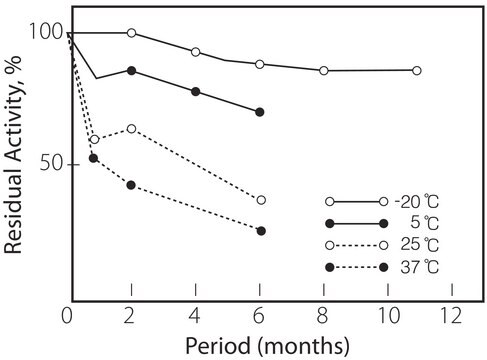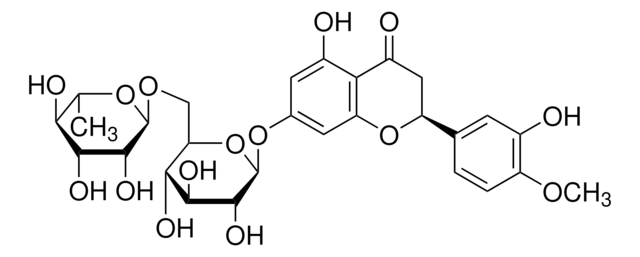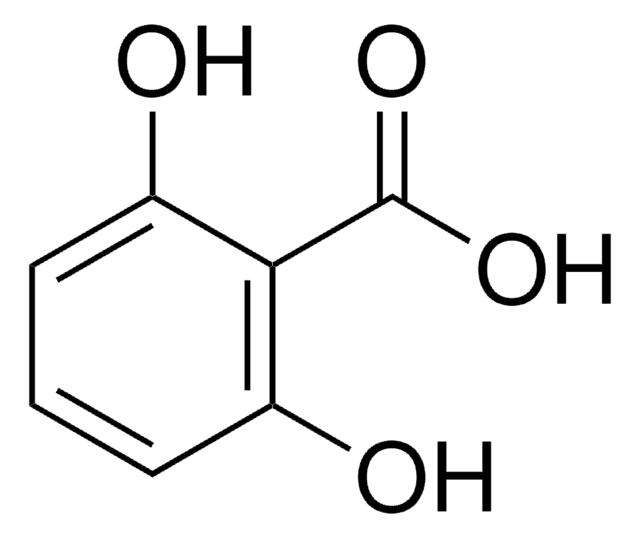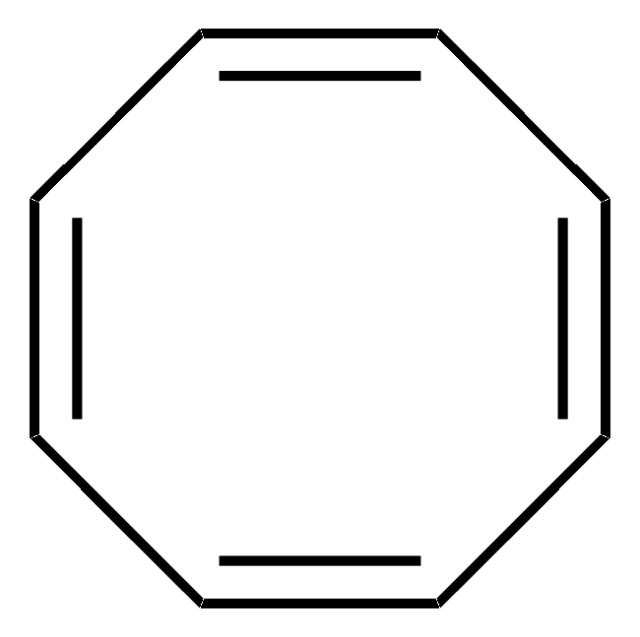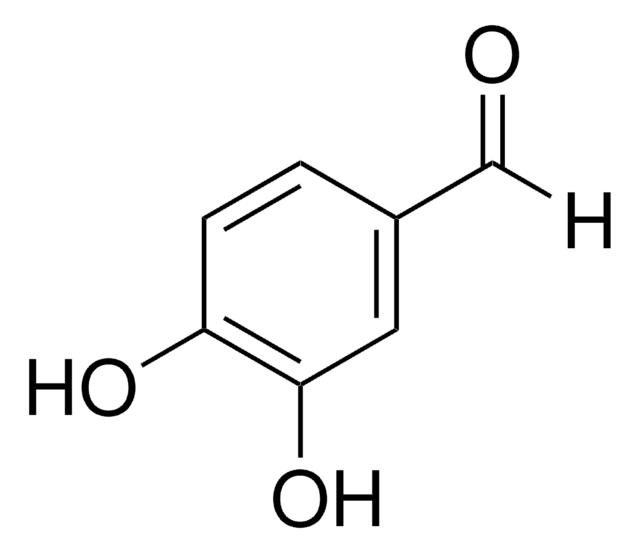37580
3,4-Dihydroxybenzoic acid
≥97.0% (T)
Sinonimo/i:
Protocatechuic acid
Autenticatiper visualizzare i prezzi riservati alla tua organizzazione & contrattuali
About This Item
Formula condensata:
(HO)2C6H3CO2H
Numero CAS:
Peso molecolare:
154.12
Beilstein:
1448841
Numero CE:
Numero MDL:
Codice UNSPSC:
12352100
ID PubChem:
NACRES:
NA.22
Prodotti consigliati
Livello qualitativo
Saggio
≥97.0% (T)
Punto di fusione
197-200 °C (dec.) (lit.)
Gruppo funzionale
carboxylic acid
Stringa SMILE
OC(=O)c1ccc(O)c(O)c1
InChI
1S/C7H6O4/c8-5-2-1-4(7(10)11)3-6(5)9/h1-3,8-9H,(H,10,11)
YQUVCSBJEUQKSH-UHFFFAOYSA-N
Cerchi prodotti simili? Visita Guida al confronto tra prodotti
Categorie correlate
Descrizione generale
3,4-Dihydroxybenzoic acid is reported as dietery polyphenol. Antiviral activity of 3,4-dihydroxybenzoic acid (protocatechuic acid, PCA) against a virulent H9N2 strain in a mouse model is reported. Cytotoxic effects of PCA on 3 non-small cell lung cancer (NSCLC) cell lines, A549, H3255, and Calu-6 cell lines is reported. PCA is reported to prevent the carcinogenesis or antitumor growth in vivo. Signaling pathway involved in PCA-induced apoptosis in human gastric adenocarcinoma (AGS) cells is reported. The oxidation of 3,4-dihydroxybenzoic acid by H2O2 in aqueous/goethite slurry at varying operating conditions (catalyst load, temperature, pH, substrate and hydrogen peroxide starting concentration) is investigated.
Applicazioni
3,4-Dihydroxybenzoic acid is suitable for use in a study to investigate the effect of 4-coumaric and 3,4-dihydroxybenzoic acid on the basal oxidative DNA damage of rat colonic mucosa in vivo. It may be used in the derivatization of chitosan resin.
Azioni biochim/fisiol
Chemopreventive in several animal models of carcinogenesis. Blocks cell proliferation in the post-initiation phase.
Avvertenze
Warning
Indicazioni di pericolo
Consigli di prudenza
Classi di pericolo
Eye Irrit. 2 - Skin Irrit. 2 - STOT SE 3
Organi bersaglio
Respiratory system
Codice della classe di stoccaggio
11 - Combustible Solids
Classe di pericolosità dell'acqua (WGK)
WGK 1
Punto d’infiammabilità (°F)
Not applicable
Punto d’infiammabilità (°C)
Not applicable
Dispositivi di protezione individuale
dust mask type N95 (US), Eyeshields, Gloves
Scegli una delle versioni più recenti:
Possiedi già questo prodotto?
I documenti relativi ai prodotti acquistati recentemente sono disponibili nell’Archivio dei documenti.
I clienti hanno visto anche
Akhmad Sabarudin et al.
Analytica chimica acta, 581(2), 214-220 (2007-03-28)
A chitosan resin derivatized with 3,4-dihydroxybenzoic acid moiety (CCTS-DHBA resin) was newly synthesized for the collection/concentration of trace uranium by using cross-linked chitosan (CCTS) as base material, and the adsorption behavior of uranium as well as 60 elements on the
Francesco Guglielmi et al.
The British journal of nutrition, 89(5), 581-587 (2003-05-02)
The effect of 4-coumaric and 3,4-dihydroxybenzoic (protocatechuic) acid on the basal oxidative DNA damage of rat colonic mucosa in vivo was studied, relative to vitamin E. F344 rats were treated with 4-coumaric or protocatechuic acid mixed in the diet (25
Hui-Hsuan Lin et al.
International journal of cancer, 120(11), 2306-2316 (2007-02-17)
3,4-Dihydroxybenzoic acid (protocatechuic acid, PCA) is discussed to represent antioxidative food components in a human diet rich in fruits and vegetables, and has been shown to prevent carcinogenesis or antitumor growth in vivo. However, the molecular mechanisms involved in chemopreventive
Roberto Andreozzi et al.
Water research, 36(11), 2761-2768 (2002-07-31)
The oxidation by H2O2 of 3,4-dihydroxybenzoic acid (3,4-DHB) in aqueous/goethite slurry at varying operating conditions (catalyst load, temperature, pH, substrate and hydrogen peroxide starting concentration) is investigated. At adopted catalyst loads the observed kinetic developments are consistent with a non-radicalic
Shih-ming Tsao et al.
Nutrition and cancer, 66(8), 1331-1341 (2014-10-31)
Cytotoxic effects of protocatechuic acid (PCA) upon 3 nonsmall cell lung cancer (NSCLC) cell lines, A549, H3255, and Calu-6 cell lines, were examined. PCA at 1, 2, 4, and 8 μM was used to treat these cells. Results showed that
Il team dei nostri ricercatori vanta grande esperienza in tutte le aree della ricerca quali Life Science, scienza dei materiali, sintesi chimica, cromatografia, discipline analitiche, ecc..
Contatta l'Assistenza Tecnica.
